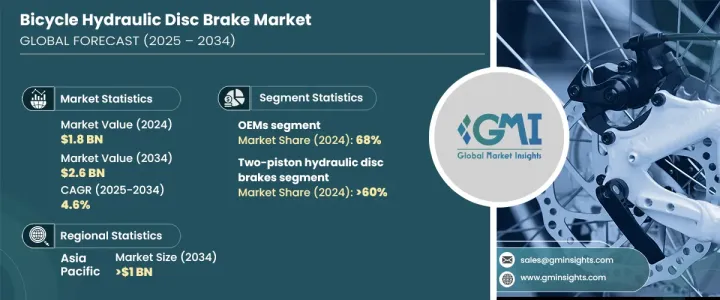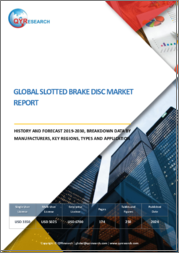
|
시장보고서
상품코드
1684671
자전거 유압 디스크 브레이크 시장 : 기회, 성장 촉진요인, 산업 동향 분석(2025-2034년)Bicycle Hydraulic Disc Brake Market Opportunity, Growth Drivers, Industry Trend Analysis, and Forecast 2025 - 2034 |
||||||
세계의 자전거 유압 디스크 브레이크 시장은 2024년에 18억 달러로 평가되었으며, 2025년부터 2034년에 걸쳐 4.6%의 연평균 성장률(CAGR)로 성장할 것으로 예측되고 있습니다.
이러한 성장은 안전과 성능 향상을 위해 고급 브레이크 시스템이 필요한 전기 자전거(e-bike)의 인기 상승에 힘입은 것입니다. 기존 자전거에 비해 무게가 무겁고 속도가 빠른 전기 자전거는 최적의 제어를 보장하기 위해 안정적이고 효율적인 제동 메커니즘이 필요합니다. 도시형 자전거 트렌드의 급증, 환경에 대한 인식의 증가, 고성능 자전거의 보급 증가로 인해 유압 디스크 브레이크에 대한 수요가 더욱 증가하고 있습니다. 제동 기술이 발전하고 주요 도시에 자전거 인프라가 확대됨에 따라 소비자들은 우수한 안전 기능을 갖춘 자전거를 점점 더 많이 찾고 있습니다. 시장의 경쟁 환경은 제조업체들이 비용, 성능, 내구성의 균형을 맞추는 제동 솔루션을 제공하는 데 주력하면서 일반 라이더부터 프로 사이클리스트까지 다양한 고객층을 만족시키기 위해 끊임없는 혁신으로 특징지어집니다.

시장은 브레이크 시스템의 피스톤 수에 따라 2피스톤 유압 디스크 브레이크와 4피스톤 유압 디스크 브레이크의 두 가지 주요 부문으로 나뉩니다. 2024년에는 2피스톤 유압식 디스크 브레이크가 60%의 압도적인 시장 점유율을 차지했으며 2034년에는 15억 달러에 달할 것으로 예상됩니다. 이 브레이크는 성능과 비용 효율성 사이에서 완벽한 균형을 이루고 있어 활용도가 매우 높습니다. 다양한 지형에서 안정적인 제동력을 제공하므로 산악자전거, 로드바이크, 전기 자전거 모두에 적합합니다. 라이더와 제조업체 모두 2피스톤 시스템의 적응성과 경제성을 높이 평가하여 널리 채택되고 있습니다.
| 시장 범위 | |
|---|---|
| 시작 연도 | 2024년 |
| 예측 연도 | 2025-2034년 |
| 시작 금액 | 18억 달러 |
| 예측 금액 | 26억 달러 |
| CAGR | 4.6% |
판매 채널 측면에서 시장은 주문자 상표 부착 생산(OEM)과 애프터마켓 부문으로 분류됩니다. OEM 부문은 2024년 시장 점유율의 68%를 차지하며 유압 디스크 브레이크 채택에 있어 중추적인 역할을 하고 있습니다. OEM 업체들은 안전과 성능을 향상시키는 첨단 사전 설치형 브레이크 시스템이 장착된 자전거에 대한 소비자 선호도가 높아짐에 따라 이에 대응하고 있습니다. 산악 자전거, 로드 자전거, 전기 자전거 등 고급 자전거에 유압식 디스크 브레이크를 기본으로 장착하여 프리미엄 라이딩 경험을 보장하는 제품이 점점 더 많아지고 있습니다. 자전거 애호가들이 최신 성능 기준을 충족하기 위해 기존 자전거를 첨단 브레이크 시스템으로 업그레이드하면서 애프터마켓 부문도 중요한 역할을 하고 있습니다.
아시아태평양 지역은 2024년 자전거 유압 디스크 브레이크 시장의 40%를 차지하며 상당한 수익을 창출했습니다. 2034년에는 10억 달러에 달할 것으로 예상됩니다. 중국이 주도하는 이 지역은 자전거 제조 및 부품 생산의 글로벌 허브입니다. 전기 자전거와 고성능 자전거의 인기가 높아지면서 혁신적인 제동 시스템에 대한 수요가 증가하고 있습니다. 도시화 추세와 지속 가능한 교통수단으로서 자전거의 매력은 아시아태평양 지역의 시장 성장을 더욱 강화하여 업계의 미래를 형성하는 데 있어 이 지역의 중요한 역할을 공고히 하고 있습니다.
목차
제1장 조사 방법과 조사 범위
- 조사 디자인
- 조사 접근
- 데이터 수집 방법
- 기본 추정과 계산
- 기준연도의 산출
- 시장추계의 주요 동향
- 예측 모델
- 1차 조사와 검증
- 1차 정보
- 데이터 마이닝 소스
- 시장 정의
제2장 주요 요약
제3장 업계 인사이트
- 생태계 분석
- 공급자의 상황
- 원재료 공급자
- 부품 제조업체
- 브레이크 시스템 조립 제조업체/브랜드
- 자전거 제조업체(OEM)
- 유통업체, 소매업체, 애프터마켓업체
- 이익률 분석
- 비용 내역
- 가격 분석
- 기술과 혁신의 전망
- 주요 뉴스 및 대처
- 규제 상황
- 영향요인
- 성장 촉진요인
- 전기 자전거의 채택 증가
- 유압 디스크 브레이크의 성능 및 안전성 향상
- 전 세계적으로 레크리에이션 사이클링, 프로 스포츠 및 피트니스 트렌드의 급증
- 친환경 운송 옵션으로의 전환
- 브레이크 기술의 기술 발전
- 업계의 잠재적 위험 및 과제
- 림 브레이크에 비해 높은 비용
- 유지 보수 및 수리의 복잡성
- 성장 촉진요인
- 성장 가능성 분석
- Porter's Five Forces 분석
- PESTEL 분석
제4장 경쟁 구도
- 소개
- 기업 점유율 분석
- 경쟁 포지셔닝 매트릭스
- 전략 전망 매트릭스
제5장 시장 추계 및 예측 : 제품별(2021-2034년)
- 주요 동향
- 2피스톤
- 4피스톤
제6장 시장 추계 및 예측 : 소재별(2021-2034년)
- 주요 동향
- 스틸 로터
- 알루미늄 로터
- 탄소 로터
제7장 시장 추계 및 예측 : 자전거별(2021-2034년)
- 주요 동향
- 로드 자전거
- 산악 자전거
- 하이브리드/통근 오토바이
- 전기 자전거(E-bike)
- 투어링 오토바이
- 트랙 오토바이
제8장 시장 추계 및 예측 : 판매 채널별(2021-2034년)
- 주요 동향
- OEM
- 애프터마켓
제9장 시장 추계 및 예측 : 지역별(2021-2034년)
- 주요 동향
- 북미
- 미국
- 캐나다
- 유럽
- 영국
- 독일
- 프랑스
- 스페인
- 이탈리아
- 러시아
- 북유럽
- 아시아태평양
- 중국
- 인도
- 일본
- 한국
- 뉴질랜드
- 동남아시아
- 라틴아메리카
- 브라질
- 멕시코
- 아르헨티나
- 중동 및 아프리카
- UAE
- 남아프리카
- 사우디아라비아
제10장 기업 프로파일
- Ashima
- BBB Cycling
- Campagnolo
- Clarks Cycle Systems
- Formula Italy
- Hayes Performance Systems
- Henan Golden Hoop Brake
- Hope Technology
- Jiande Wuxing Bicycle
- Kobelt Manufacturing
- Magura
- 시마노
- SR Suntour
- SRAM
- SwissStop
- Tektro
- Trickstuff
- TRP Cycling
- TRW Automotive
- Uberbike Components
The Global Bicycle Hydraulic Disc Brake Market was valued at USD 1.8 billion in 2024 and is anticipated to grow at a robust CAGR of 4.6% from 2025 to 2034. This growth is driven by the rising popularity of electric bicycles (e-bikes), which require advanced braking systems for improved safety and performance. E-bikes, known for their heavier build and faster speeds compared to traditional bicycles, demand reliable and efficient braking mechanisms to ensure optimal control. The surge in urban cycling trends, increased environmental awareness, and the growing adoption of high-performance bicycles are further fueling the demand for hydraulic disc brakes. With advancements in braking technologies and the expansion of cycling infrastructure across major cities, consumers are increasingly seeking bikes equipped with superior safety features. The market's competitive landscape is characterized by constant innovation as manufacturers focus on delivering braking solutions that balance cost, performance, and durability, catering to a diverse customer base ranging from casual riders to professional cyclists.

The market is divided into two key segments based on the number of pistons in the brake system: two-piston hydraulic disc brakes and four-piston hydraulic disc brakes. In 2024, two-piston hydraulic disc brakes commanded a dominant 60% market share and are projected to reach USD 1.5 billion by 2034. These brakes strike the perfect balance between performance and cost-effectiveness, making them highly versatile. They deliver reliable stopping power across various terrains, making them suitable for mountain bikes, road bikes, and e-bikes alike. Riders and manufacturers alike appreciate the adaptability and affordability of two-piston systems, contributing to their widespread adoption.
| Market Scope | |
|---|---|
| Start Year | 2024 |
| Forecast Year | 2025-2034 |
| Start Value | $1.8 Billion |
| Forecast Value | $2.6 Billion |
| CAGR | 4.6% |
In terms of sales channels, the market is categorized into original equipment manufacturers (OEMs) and the aftermarket segment. The OEM segment captured 68% of the market share in 2024, underscoring its pivotal role in the adoption of hydraulic disc brakes. OEMs are responding to growing consumer preferences for bicycles equipped with advanced, pre-installed braking systems that enhance safety and performance. High-end bicycles, including mountain bikes, road bikes, and e-bikes, increasingly feature hydraulic disc brakes as a standard offering, ensuring a premium riding experience. The aftermarket segment also plays a significant role as cycling enthusiasts upgrade their existing bikes with advanced braking systems to meet modern performance standards.
The Asia Pacific region accounted for 40% of the bicycle hydraulic disc brake market in 2024, generating substantial revenue. By 2034, it is expected to reach USD 1 billion. Led by China, this region is a global hub for bicycle manufacturing and component production. The increasing popularity of e-bikes and high-performance bicycles is driving the demand for innovative braking systems. Urbanization trends and the growing appeal of cycling as a sustainable mode of transportation further bolster market growth in Asia Pacific, cementing the region's critical role in shaping the industry's future.
Table of Contents
Chapter 1 Methodology & Scope
- 1.1 Research design
- 1.1.1 Research approach
- 1.1.2 Data collection methods
- 1.2 Base estimates and calculations
- 1.2.1 Base year calculation
- 1.2.2 Key trends for market estimates
- 1.3 Forecast model
- 1.4 Primary research & validation
- 1.4.1 Primary sources
- 1.4.2 Data mining sources
- 1.5 Market definitions
Chapter 2 Executive Summary
- 2.1 Industry 3600 synopsis, 2021 - 2034
Chapter 3 Industry Insights
- 3.1 Industry ecosystem analysis
- 3.2 Supplier landscape
- 3.2.1 Raw material suppliers
- 3.2.2 Component manufacturers
- 3.2.3 Brake system assemblers/brands
- 3.2.4 Bicycle manufacturers (OEMs)
- 3.2.5 Distributors, retailers, and aftermarket suppliers
- 3.3 Profit margin analysis
- 3.4 Cost breakdown
- 3.5 Price analysis
- 3.6 Technology & innovation landscape
- 3.7 Key news & initiatives
- 3.8 Regulatory landscape
- 3.9 Impact forces
- 3.9.1 Growth drivers
- 3.9.1.1 The growing adoption of electric bicycles
- 3.9.1.2 Enhanced performance and safety of hydraulic disc brakes
- 3.9.1.3 The surge in recreational cycling, professional sports, and fitness trends worldwide
- 3.9.1.4 The shift toward eco-friendly transportation options
- 3.9.1.5 Technological advancements in brake technologies
- 3.9.2 Industry pitfalls & challenges
- 3.9.2.1 Higher cost compared to rim brakes
- 3.9.2.2 Complexity of maintenance and repair
- 3.9.1 Growth drivers
- 3.10 Growth potential analysis
- 3.11 Porter's analysis
- 3.12 PESTEL analysis
Chapter 4 Competitive Landscape, 2024
- 4.1 Introduction
- 4.2 Company market share analysis
- 4.3 Competitive positioning matrix
- 4.4 Strategic outlook matrix
Chapter 5 Market Estimates & Forecast, By Product, 2021 - 2034 ($Bn, Units)
- 5.1 Key trends
- 5.2 Two-piston
- 5.3 Four-piston
Chapter 6 Market Estimates & Forecast, By Material, 2021 - 2034 ($Bn, Units)
- 6.1 Key trends
- 6.2 Steel rotors
- 6.3 Aluminum rotors
- 6.4 Carbon rotors
Chapter 7 Market Estimates & Forecast, By Bicycle, 2021 - 2034 ($Bn, Units)
- 7.1 Key trends
- 7.2 Road bikes
- 7.3 Mountain bikes
- 7.4 Hybrid/commuter bikes
- 7.5 Electric bikes (E-bikes)
- 7.6 Touring bikes
- 7.7 Track bikes
Chapter 8 Market Estimates & Forecast, By Sales Channel, 2021 - 2034 ($Bn, Units)
- 8.1 Key trends
- 8.2 OEMs
- 8.3 Aftermarket
Chapter 9 Market Estimates & Forecast, By Region, 2021 - 2034 ($Bn, Units)
- 9.1 Key trends
- 9.2 North America
- 9.2.1 U.S.
- 9.2.2 Canada
- 9.3 Europe
- 9.3.1 UK
- 9.3.2 Germany
- 9.3.3 France
- 9.3.4 Spain
- 9.3.5 Italy
- 9.3.6 Russia
- 9.3.7 Nordics
- 9.4 Asia Pacific
- 9.4.1 China
- 9.4.2 India
- 9.4.3 Japan
- 9.4.4 South Korea
- 9.4.5 ANZ
- 9.4.6 Southeast Asia
- 9.5 Latin America
- 9.5.1 Brazil
- 9.5.2 Mexico
- 9.5.3 Argentina
- 9.6 MEA
- 9.6.1 UAE
- 9.6.2 South Africa
- 9.6.3 Saudi Arabia
Chapter 10 Company Profiles
- 10.1 Ashima
- 10.2 BBB Cycling
- 10.3 Campagnolo
- 10.4 Clarks Cycle Systems
- 10.5 Formula Italy
- 10.6 Hayes Performance Systems
- 10.7 Henan Golden Hoop Brake
- 10.8 Hope Technology
- 10.9 Jiande Wuxing Bicycle
- 10.10 Kobelt Manufacturing
- 10.11 Magura
- 10.12 Shimano
- 10.13 SR Suntour
- 10.14 SRAM
- 10.15 SwissStop
- 10.16 Tektro
- 10.17 Trickstuff
- 10.18 TRP Cycling
- 10.19 TRW Automotive
- 10.20 Uberbike Components



















